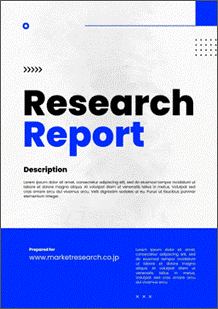 | • レポートコード:MRC2203A085 • 出版社/出版日:Mordor Intelligence / 2022年1月 • レポート形態:英文、PDF、120ページ • 納品方法:Eメール(受注後2-3営業日) • 産業分類:食品 |
| Single User | ¥703,000 (USD4,750) | ▷ お問い合わせ |
| Site Licence | ¥962,000 (USD6,500) | ▷ お問い合わせ |
| Corporate License | ¥1,295,000 (USD8,750) | ▷ お問い合わせ |
• お支払方法:銀行振込(納品後、ご請求書送付)
レポート概要
| Mordor Intelligence社の本市場調査レポートでは、世界の飴市場について調査・分析し、イントロダクション、調査手法、エグゼクティブサマリー、市場動向、種類別(チョコレート飴、非チョコレート飴)分析、流通チャネル別(スーパーマーケット/ハイパーマーケット、コンビニエンスストア、専門小売業者、オンライン小売、その他)分析、地域別(北米、ヨーロッパ、アジア太平洋、南米、中東・アフリカ)分析、競争状況、市場機会・将来傾向、新型コロナウイルス感染症による市場への影響など、以下の構成でまとめました。 ・イントロダクション ・調査手法 ・エグゼクティブサマリー ・市場動向 ・世界の飴市場規模:種類別(チョコレート飴、非チョコレート飴) ・世界の飴市場規模:流通チャネル別(スーパーマーケット/ハイパーマーケット、コンビニエンスストア、専門小売業者、オンライン小売、その他) ・世界の飴市場規模:地域別(北米、ヨーロッパ、アジア太平洋、南米、中東・アフリカ) ・競争状況(Perfetti Van Melle Group BV、Mondelez International Inc.、Mars Incorporated、…) ・市場機会・将来傾向 ・新型コロナウイルス感染症による市場への影響 |
The candy market is projected to register a CAGR of 3.99% during the forecast period, 2021-2026.
Over the last year, the coronavirus had impacted every industry, and that includes the confectionery and candy industry as well, although only for the short term. Early sales data of the candy market across the globe registered a steep decline in the gums and mint category as a result of COVID-19, while chocolate candy, as well as non-chocolate candy, continues to attain strong growth.
The growing availability of different varieties of candies, both chocolate and non-chocolate candies, has led to the high demand for candies, fueled by the impulsive purchase behavior of consumers. Consumers in New England and the Midwest tend to eat the most candy. Nationwide consumption peaks around Halloween, Christmas, Valentine’s Day, and Easter.
COVID-19 also brought massive changes to the retail side of the candy industry. More consumers started using online ordering for groceries, ranging from click-and-collect to home delivery. The Hershey Company stated that its e-commerce sales were up significantly, with growth over 120% in March 2020, versus 60% in January 2020 and February 2020.
Candy products have acquired a prominent place in households across the globe due to COVID-19 lockdown implementations and lockdown extensions. The preference for sweet indulgence has increased due to more consumers working from home. Furthermore, the change in traditional patterns of food consumption may also open a pathway for innovation across the candy market across the globe as countries are recovering from the impact of the global pandemic.
Key Market Trends
The Non-chocolate Segment Holds the Largest Share of the Market
Non-chocolate candies are observing high growth in the global market, owing to the recent developments in the candy flavors, their appearance, and mouth-feel. The majority of the manufacturers are focusing on product development in line with the organic food culture across the world. Further, due to constant emphasis on clean-labeled products and stricter government regulations on the amount of sugar content in food products, organic, vegan, GMO-free, sugar-free, and kosher food colors, sweeteners, and other ingredients are being used to manufacture non-chocolate candies, which is likely to contribute to the growth of the category.
Emerging Economies are Driving the Candy Sales
Asia-Pacific leads the global candy sales, followed by North America. The target populations for the candy market are primarily children and the young population. The growing population in emerging economies has led to the high demand for candies, fueled by the impulsive purchase behavior of consumers. In developing economies, such as Asia, Africa, and South America, the per capita candy consumption, which was very low compared to their western counterparts, is slowly increasing. Many countries are witnessing campaigns and media advertisements related to innovative candy products, which are directly impacting the sales rate of sugar-based confectionery. Companies are increasingly launching products with innovative flavors such as raw mango, tamarind, strawberry, etc., to attract consumers in these emerging markets.
Competitive Landscape
Based on the nature of the market and with virtually no entry barriers, the candy market globally is very competitive with a huge number of domestic companies capturing minimal share in the market. Some of the prominent players include Perfetti Van Melle Group BV, Mondelez International Inc., Mars Incorporated, The Hershey Company, and others. Owing to the rapidly developing nature of the market, launching a new product has become the most important strategy, among all. Companies have adopted expansion as the key strategy, followed by mergers and acquisitions. This attempt of global players has proven successful in making their presence stronger with high market shares.
Additional Benefits:
- The market estimate (ME) sheet in Excel format
- 3 months of analyst support
1 INTRODUCTION
1.1 Study Assumptions and Market Definition
1.2 Scope of the Study
2 RESEARCH METHODOLOGY
3 EXECUTIVE SUMMARY
4 MARKET DYNAMICS
4.1 Market Drivers
4.2 Market Restraints
4.3 Porter’s Five Forces Analysis
4.3.1 Threat of New Entrants
4.3.2 Bargaining Power of Buyers/Consumers
4.3.3 Bargaining Power of Suppliers
4.3.4 Threat of Substitute Products
4.3.5 Intensity of Competitive Rivalry
5 MARKET SEGMENTATION
5.1 By Type
5.1.1 Chocolate Candy
5.1.2 Non-chocolate Candy
5.1.2.1 Hard Boiled Candies
5.1.2.2 Pastilles, Gums, Jellies, and Chews
5.1.2.3 Toffees, Caramels, and Nougat
5.1.2.4 Mints
5.1.2.5 Other Non-chocolate Candies
5.2 By Distribution Channel
5.2.1 Supermarkets/Hypermarkets
5.2.2 Convenience Stores
5.2.3 Specalist Retailers
5.2.4 Online Retail
5.2.5 Other Distribution Channels
5.3 Geography
5.3.1 North America
5.3.1.1 United States
5.3.1.2 Canada
5.3.1.3 Mexico
5.3.1.4 Rest of North America
5.3.2 Europe
5.3.2.1 Germany
5.3.2.2 United Kingdom
5.3.2.3 France
5.3.2.4 Russia
5.3.2.5 Italy
5.3.2.6 Spain
5.3.2.7 Rest of Europe
5.3.3 Asia-Pacific
5.3.3.1 India
5.3.3.2 China
5.3.3.3 Australia
5.3.3.4 Japan
5.3.3.5 Rest of Asia-Pacific
5.3.4 South America
5.3.4.1 Brazil
5.3.4.2 Argentina
5.3.4.3 Rest of South America
5.3.5 Middle-East and Africa
5.3.5.1 United Arab Emirates
5.3.5.2 South Africa
5.3.5.3 Rest of Middle-East and Africa
6 COMPETITIVE LANDSCAPE
6.1 Most Active Companies
6.2 Market Share Analysis
6.3 Strategies Adapted by Leading Companies
6.4 Company Profiles
6.4.1 Perfetti Van Melle Group BV
6.4.2 Mondelez International Inc.
6.4.3 Mars Incorporated
6.4.4 Haribo GmbH & Co. KG
6.4.5 Nestle SA
6.4.6 The Hershey Company
6.4.7 Ferrero Group
6.4.8 Cloetta Ab
6.4.9 Grupo Arcor
6.4.10 The Topps Company Inc.
7 MARKET OPPORTUNITIES AND FUTURE TRENDS
8 IMPACT OF COVID-19 ON THE MARKET